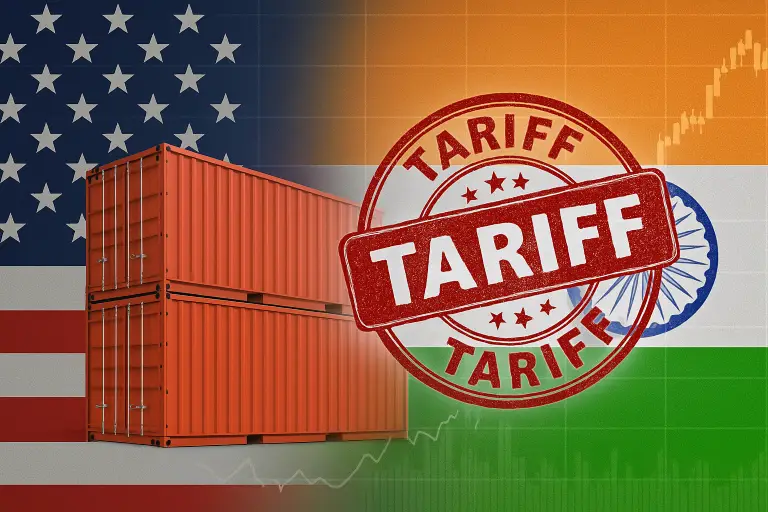Background
On April 2, 2025, former U.S. President Donald Trump announced sweeping tariffs comprising a 10% baseline on all imports and an additional 26% on goods from India. Effective April 5 and April 9, these measures mark a return to aggressive protectionism and have triggered widespread economic ripple effects in India, beginning with pressure on the rupee. Although the current tariff is blanket in nature, there is potential for exemptions on products not produced domestically in the U.S. or tied to cost-of-living concerns.
India’s Trade at a Crossroads
The United States remains India’s largest export destination, with outbound trade reaching nearly $78 billion in FY2024 and already exceeding $69 billion in the first ten months of FY2025—reflecting a 9% year-on-year growth. However, the newly imposed 36% effective tariff now threatens this momentum, especially in labor-intensive and price-sensitive sectors such as textiles, engineering goods, and electronics.
Although strategic sectors like pharmaceuticals, energy, semiconductors, and critical minerals have been exempted, the broader export portfolio faces a sharp decline in competitiveness. The fallout could result in shrinking export volumes, underutilized manufacturing capacity, and job losses, particularly within India’s MSME ecosystem.
To mitigate these risks, India and the U.S. have initiated bilateral trade negotiations. Talks held in March 2025 aim to finalize a phased trade agreement by autumn. The U.S. is pressing for greater access to India’s industrial and agricultural markets, while India is advocating for tariff relief on laborintensive exports—such as shrimp, where India currently faces a 36% tariff compared to Ecuador’s 10%. Industry stakeholders are hopeful that the tariff on Indian shrimp will soon be aligned with that of its competitors.
As part of its negotiation strategy, India has offered concessions on select U.S. imports, including liquefied natural gas (LNG), almonds, and cranberries, while remaining firm on politically sensitive sectors like dairy. Both sides are working toward the shared objective of doubling bilateral trade to $500 billion by 2030, underscoring the strategic importance of economic cooperation amid shifting global trade dynamics
Dumping Risk from East Asia
As the U.S. restricts cheaper imports from China, Vietnam, and Taiwan—some facing tariffs of up to 60%—these countries may redirect surplus goods to India. The result could be a surge in dumped products at undercut prices, threatening domestic manufacturers
High-risk sectors include:
- Electronics: Smartphones, PCBs, semiconductors
- Metals: Steel coils, aluminum products
- Pharma APIs: Intermediates and bulk drugs
- Textiles: Synthetic fabrics, garments
- Machinery: HVAC systems, tooling components
This influx could destabilize local ecosystems already under strain from raw material dependency and global headwinds.
India’s Supply Chain Paradox: Dependency and Opportunity
India’s ambition to replace East Asia in global value chains is undercut by its deep reliance on Chinese imports. Over 70% of pharmaceutical APIs and critical components for electronics and automobiles are sourced from China. This dependency exposes Indian exporters to cost volatility and supply disruptions, limiting scalability and weakening competitiveness. Yet, this vulnerability also reveals an opportunity. The U.S. remains heavily dependent on imports for products it does not manufacture at scale, including:
- Critical minerals: Rare earths, cobalt
- Pharmaceuticals: Generic drugs and APIs
- Technology: Semiconductors and high-tech components
- Agriculture: Tropical goods like coffee, cocoa, and fruits
If India can reduce its input dependency and overcome internal production bottlenecks, it could emerge as a reliable alternative supplier to the U.S.—strengthening its role in reconfigured global supply chains
Can Domestic Demand Cushion the Shock?
India’s robust domestic consumption could play a critical role in offsetting export losses. Sectors such as construction, FMCG, and retail are well-positioned to absorb some of the excess capacity created by weakened external demand. However, in the absence of effective safeguards, this internal demand could be exploited by dumped imports, further undermining local industry competitiveness. To ensure that domestic consumption supports Indian manufacturers rather than foreign surplus, strong trade defense mechanisms—such as anti-dumping duties and quality control measures—are essential. Encouragingly, recent fiscal and monetary measures announced in February 2025 are expected to bolster household spending, providing additional support to domestic demand in the months ahead.
Macroeconomic Risks: Inflation and Twin Deficits
While dumped imports may temporarily lower prices, the broader economic impact could be inflationary. Rising input costs—fueled by elevated global commodity prices and a depreciating rupee—are likely to increase India’s import bill, particularly in energy, electronics, and pharmaceuticals. This erodes consumer purchasing power and complicates the Reserve Bank of India’s monetary strategy.
At the same time, slowing exports, a weakening currency, and costlier imports could significantly widen the current account deficit (CAD). On the fiscal front, reduced tax revenues from affected sectors, combined with increased subsidy requirements, could strain the fiscal deficit. These pressures demand coordinated macroeconomic and trade policy responses.
India’s Policy Roadmap
To navigate this disruption and seize emerging opportunities, India must:
- Enforce anti-dumping duties in vulnerable sectors
- Boost domestic manufacturing with PLI schemes for electronics, APIs, and machinery
- Tighten import quality norms through BIS standards
- Accelerate FTAs with the EU, UK, and ASEAN
- Stabilize the rupee through prudent monetary and reserve management

